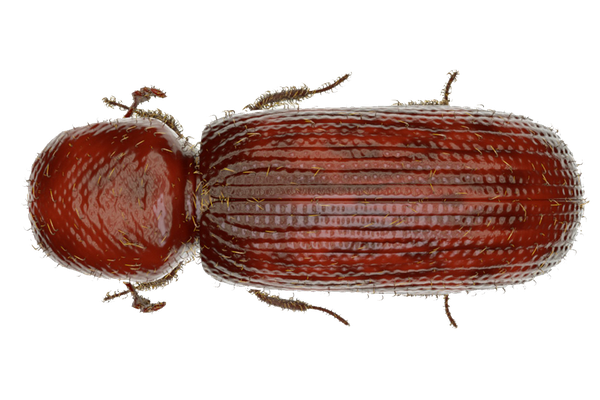| Description | Dark brown cylindrical beetle (2.5–3 mm long). The head is hidden under the round neck-shield, with mouthparts and eyes only visible from the side. |
|---|---|
| Distribution | Cosmopolitan, occurs in both temperate and tropical regions. In Australia, it is found in all grain-growing regions. |
| Pest status | Major, widespread and regular. It is a primary pest of stored grain. |
| Host range | Mainly an internal feeder and a serious pest of both whole kernel stored grain and cereal products. Primarily a pest of stored wheat and corn but can infest tobacco, nuts, beans, birdseed, biscuits, cassava, cocoa beans, dried fruit, peanuts, spices, rodenticide baits, and dried meat and fish. |
| Damage | Damage caused by this pest is quite prominent and heavy. Adults and larvae bore into undamaged kernels reducing them to hollow husks. They are also able to survive and develop in the accumulated ´debris´ produced as the seeds are chewed up. The damaged seeds are always surrounded by powder from the chewed-up grain. |
| Risk period | All year. |
| Life cycle | Adults are strong fliers and live for 2–3 months. Females lay eggs singly or in clusters. The eggs are laid on the outside of the grain and a female can lay from 300–500 eggs. Young larvae initially feed on the outside of the grain but later stages bore into the grain and complete their development inside. Emerging adults bore their way out. Lesser grain borer develops in grains of lower water content than most other important pest species. Life cycle takes 4 weeks at 35ºC and 7 weeks at 22ºC. Development stops below 18ºC. |
| Means of protection |
Cultural control – The insect does not occur in standing crops. Therefore, good hygiene with storage and handling equipment should minimise infection. Prevention treatment by Methograin Delta IGR Grain Protectant is the primarily recommended product for prevention. To gain the widest possible range of protection Methograin Delta IGR Grain Protectant together with Methograin Fenitrothion 1000 can be applied. Chemical control – In case of infestation, fumigation in sealed storage. |
